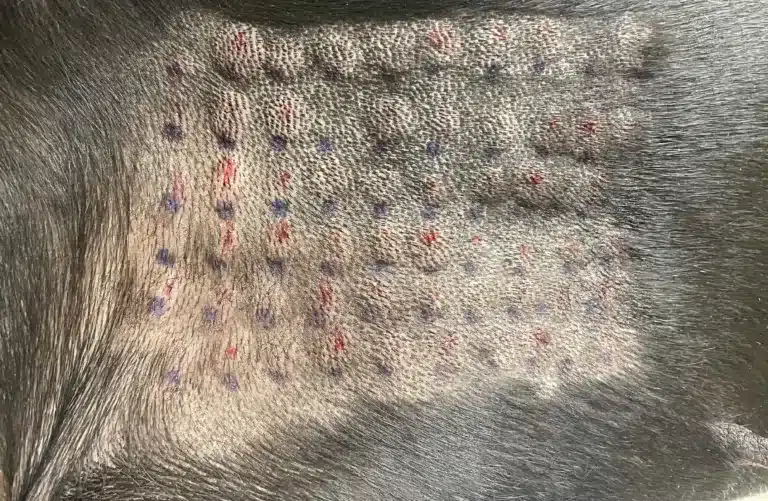Resources
Veterinary Dermatology FAQ

Skin infections and ear infections are generally SECONDARY to an underlying PRIMARY skin disorder that is affecting the skin barrier or immune system of the skin. The most common cause of recurrent skin infections in dogs is allergic skin disease. When the patient is exposed to something she is allergic to, her skin responds by becoming inflamed. This inflammation changes the microhabitat of the skin, from one that is naturally dry, arid and inhibitory of bacteria and yeast overgrowth, to one that is moist and humid, in which the normal flora bacteria and yeast can proliferate out of control and cause infection. These infections, therefore, are not contagious—instead, they are overgrowths of the normal bacteria and yeast that are present on the skin.
The second most common cause of recurrent skin infections are endocrine disorders. Endocrine disorders occur when there are abnormal amounts of normal hormones that are important for skin health. The two most common conditions are hypothyroidism and Cushing’s disease, where the body makes too much stress hormone (cortisol). These conditions lead to suppression of the skin’s immune system, which allows the normal flora bacteria and yeast proliferate and cause infection. Endocrine disorders typically cause other clinical signs in addition to skin disease. For example, Cushing’s disease can cause excessive thirst, urination, and eating, and patients often have a pot-bellied appearance. Hypothyroidism can be associated with lethargy and weight gain.
When your pet is suffering from hairloss, it’s important to determine if this is inflammatory hairloss—meaning that the involved skin is itchy and red, or if this is non-inflammatory hairloss, where the involved underlying skin appears normal and is not itchy. In general, non-inflammatory and inflammatory hairloss are caused by different diseases.
- Causes of inflammatory hairloss include: allergic dermatitis, ectoparasites (fleas, mites) infestation, infection (bacterial, fungal, viral), immune-mediated conditions (sebaceous adenitis, pemphigus foliaceus), and skin cancer (cutaneous lymphoma).
- Causes of non-inflammatory hairloss include: endocrine disorders (hypothyroidism, Cushing’s, sex-hormone associated alopecia), hair cycle arrest (conditions where the hair follicles stop cyclcing normally, including cyclic flank alopecia, Alopecia X), follicular dysplasia (structural abnormalities of the hair follicles, such as black hair follicular dysplasia or color dilution alopecia), and self-induced/behavioral hair pulling in cats (barbering).
- Nationwide, the most common reason for itchiness in dogs and cats nationwide is ectoparasites—the creepy crawlies—usually fleas and mites. Flea bite allergy often causes hairloss and itchiness over the rump and tail area. In cats, it can be associated with a particular allergy manifestation called miliary dermatitis, which are little raised crusted bumps, usually on the trunk and neck. Fleas may not always be visible, particularly in cats, who groom them off. Mites are microscopic and cannot be detected with the naked eye. Sarcoptic mange is an itchy, contagious mite endemic in the fox population. This mite often causes crusting on the edges of the ears, elbows, and hocks, and tremendous, severe itchiness that often responds poorly to anti-itch medication. Ectoparasites particularly should be considered if the patient has no prior history of being itchy, or if they are of an unusual age to develop allergic skin disease (ie, greater than 5 years of age).
- The next most common cause of itchiness is, by far, allergic skin disease. Allergic skin disease generally manifests as itchiness and/or inflammation (red skin) of the feet, face, armpits, belly, and rear end, and typically afflicts young animals (ie, first clinical signs less than 5 years of age). It can be seasonal or year-round depending on what the patient is allergic to. Certain dog breeds are genetically predisposed, such as English and French Bulldogs, German Shepherds, Labrador Retrievers, Golden Retrievers, Labradoodles, Golden Doodles, Pit Bulls, and many terrier breeds.
- Skin infections: Bacterial and fungal infections can cause significant itchiness. While fungal infections such as ringworm can be primary infections (meaning that the infection is not caused by something else), most bacterial and yeast infections are secondary to a primary skin disease, such as skin allergies or endocrine disorders like hypothyroidism or Cushing’s disease.
- Other potential causes of itchiness are less common: immune-mediated conditions such as sebaceous adenitis (where the immune system destroys the skin’s sebaceous glands) and pemphigus foliaceus (where the immune system destroys the connection between skin cells) can both be severely itchy, as can a type of skin cancer called epitheliotropic cutaneous lymphoma.
Veterinary dermatologists are at the cutting edge of laser surgery in veterinary medicine. Today’s surgical lasers help speed up healing time by decreasing inflammation of the surrounding tissue. At Unleashed, our laser is a Vetscalpel CO2 laser. Documented benefits of surgery using this instrument include decreased bleeding, decreased pain, reduced risk of infection, and faster recovery time. In addition, surgical lasers offer a unique feature—they allow the surgeon to carefully ablate the diseased tissue, almost one cell at a time, which makes them the instrument of choice for conditions that involve multiple skin lesions, such as Bowenoid carcinoma in situ, a type of skin cancer in cats, ceruminous gland cystomatosis, a type of ear cysts in cats, and sebaceous adenomas/hyperplasias in dogs, where traditional removal of all of the involved sites would be difficult, if not impossible. Laser surgery can also be performed in hard-to-reach places, such as deep in the ear canal, using our video-otoscope.
No. The diagnosis of allergies is based on a clinical diagnosis, which occurs when a pet has a medical history and clinical lesions typical of allergies, and other causes of these clinical signs have been ruled out. We recommend allergy testing only after the diagnosis of allergies has been made. The reason for this is that allergy tests can be positive even in animals who do not have allergies. For instance, a dog could be generating allergen-specific antibodies, but these antibodies are not leading to inflammation or itch. One common example in the northeast US is a pet with sarcoptic mange, a disease caused by an itchy contagious mite endemic to our native foxes. As another example, sogs with sarcoptic mange (“scabies”) are very itchy and are commonly misdiagnosed with allergies. Allergy testing on these patients might well reveal some positives to tree pollens or weed pollens, but once the sarcoptic mange is treated, these patients usually no longer show clinical signs of allergic skin disease. Therefore, it is strongly recommended to have a solid clinical diagnosis of allergic skin disease before performing allergy testing.
Allergy testing is currently only accurate for environmental allergies—for instance, allergens to pollens, trees, weeds, molds, pollens, and house dust mites. It is not currently accurate at detecting what food allergens are afflicting the pet. This is true regardless of what type of food allergy test is selected—serum (blood), saliva, or patch testing. Positive values on a food allergy test simply mean that the pet has been exposed to that allergen or something similar. The only value in performing food allergy testing is in negative values—they usually can accurately predict what the patient is NOT allergic to. Currently, the only accurate way to diagnose food allergies in dogs and cats is to perform a strict elimination diet trial using either a prescription hypoallergenic diet or a home-cooked diet. For environmental allergies, allergy testing can be accurate and helpful.
For environmental allergies, there are two forms of allergy testing that can be considered:
- Intradermal Allergy Testing: This is the gold standard method of identifying environmental allergens in dogs and cats (and horses). This test requires light, reversible sedation. Allergens such as danders, house dust mites allergens, pollens are then directly injected into the skin. The size of the allergic reaction is measured and compared to a positive control (pure histamine) and negative control (saline). This test identifies allergen-specific antibodies on mast cells inside the relevant organ, the skin. This distinct “pro” must be weighed against the potential “con” inherent with the risk of sedation and the very slight risk of an allergic reaction occurring during the procedure.
- Serum (blood) allergy testing: This test is easy to perform, as it is a simple blood draw. It aims to detect allergen-specific immunoglobulin E (IgE) to grasses, tree pollens, weed pollens, molds, and house dust mites, as well as some insects. The most important consideration with this test is the laboratory the sample is submitted to, as the accuracy of laboratories can have important differences. For example, it is crucial that the laboratory use Cross-reactive Carbohydrate Determinants (CCD) blockers. CCDs occur on many plant allergens, and animals can develop antibodies to CCDs. Because these molecules can be present across many different allergens, many false positives can be detected. By blocking the CCDs, this false positivity is prevented.
Patient Forms
News

Veterinary noncompetes in light of FTC ban
At Unleashed Veterinary Dermatology, we were pleased to see the April 23 ruling by the Federal Trade Commission banning most noncompete agreements from the workplace.

Our first patient
Our very first patient is Ferris, a very beloved patient that Dr. Falk has known for years.

Take a tour
Take a tour of our newly renovated clinic. We renovated it with a focus on fear-free principles and the comfort of our clients and patients.

Online self-scheduling is now available
Online appointment booking Do you like to reserve appointments from the convenience of your computer or device? So do we! We are pleased to announce

Renovations underway
After several months of planning with our architect and contractor, the renovations for our clinic have now begun. They include modernizing our facility, adding exam

Treatment options for Canine Allergic Dermatitis
Long-term allergy medications There are two main reasons to treat your dog with allergy medications: he is excessively itchy, and/or he is suffering from recurrent

Should I get an allergy test for my dog or cat?
Allergy testing is one of the most common reasons cats and dogs visit a veterinary dermatologist. When considering allergy testing for a beloved pet, there

